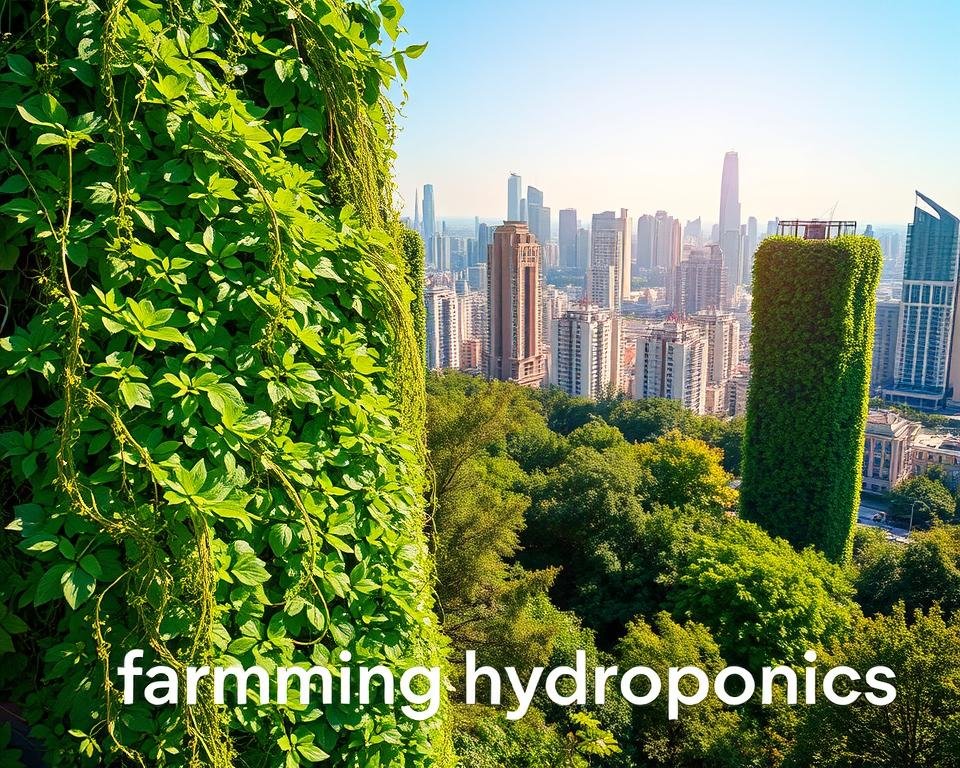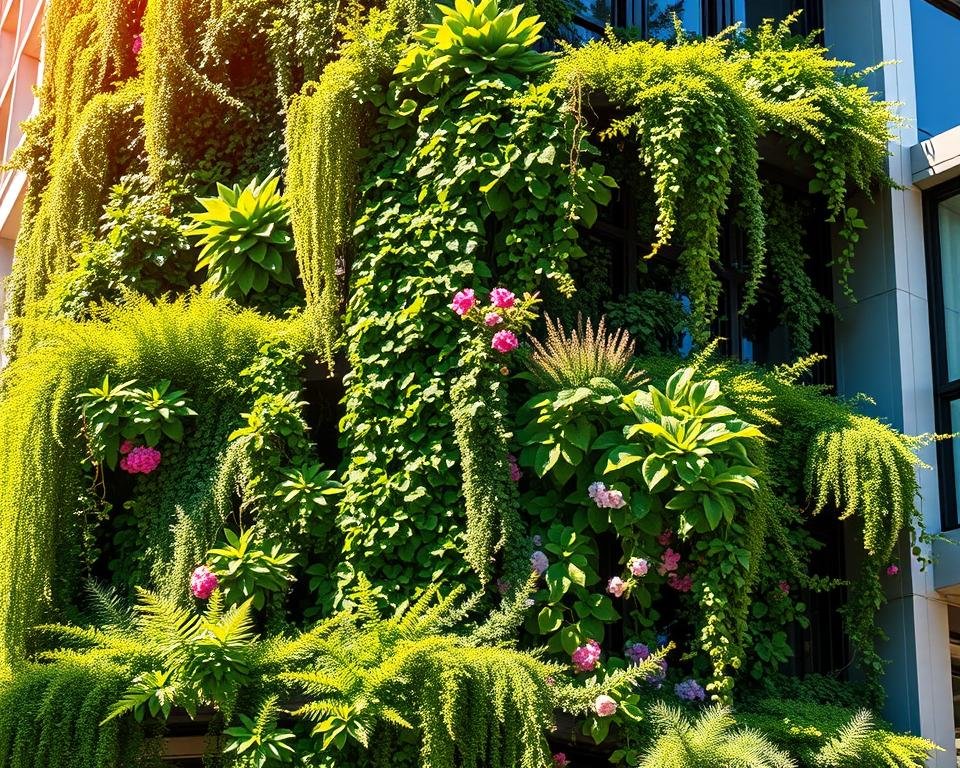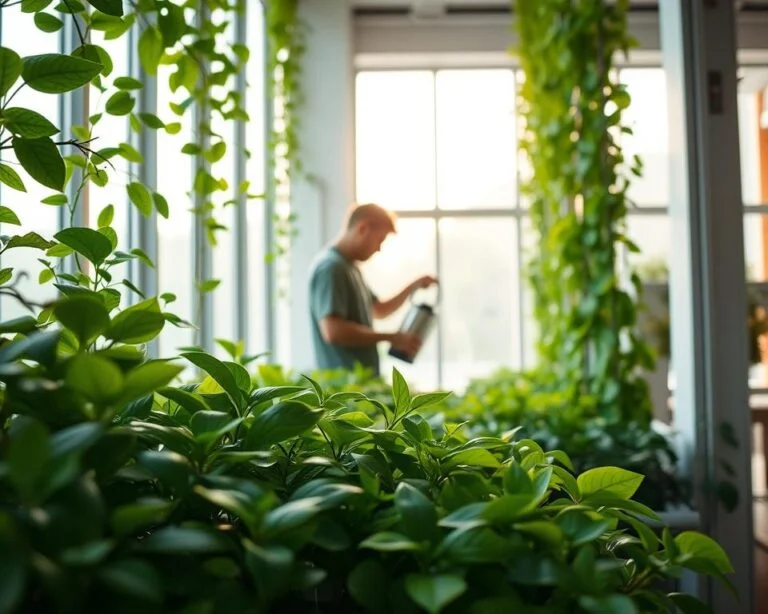Enhancing Air Quality with Vertical Gardens
Imagine walking into a space where the air feels crisp and clean. This isn’t a dream—it’s the power of vertical-gardens. Urban dwellers are finding a new way to fight pollution, one that goes beyond traditional methods.
Vertical-gardens are more than just pretty green walls. They are strong allies in the fight for better air quality. They turn urban areas into spaces where you can breathe easily and stay healthy.
As cities face more pollution, vertical gardens offer a new solution. They catch pollutants, take in carbon dioxide, and release oxygen. This creates a natural way to clean the air in the city’s heart.
Key Takeaways
- Vertical-gardens act as natural air purification systems
- Green walls reduce urban pollution levels significantly
- These installations contribute to mental and physical wellness
- Urban environments can be transformed through strategic greenery
- Plants in vertical-gardens actively filter harmful air particles
Understanding Vertical Gardens and Their Impact on Urban Spaces
Vertical-gardens are a new way to change city landscapes. They tackle big problems like pollution and lack of green areas. These systems turn concrete into green spaces, making cities look better and breathe cleaner.
In cities where space is tight, vertical-gardens are a smart choice. They bring nature into buildings. This can cut pollution by 30% and cool down cities.
Types of Vertical Garden Systems
There are many types of vertical-gardens for different city needs:
- Modular Panel Systems: Easy to move and change
- Pocket Gardens: Use fabric or felt to hold plants
- Trellis Structures: Help plants climb
- Hydroponic Installations: Plants grow without soil
Integration with Urban Architecture
Today’s architects are adding vertical-gardens to buildings. These green walls make cities look better. They also help clean the air by removing pollutants.
Basic Components and Structure
A vertical garden has a few main parts:
- Support for the garden
- Way to water the plants
- Soil or a soil-less growing method
- Plants that do well in the city
Vertical gardens turn empty walls into living spaces. They are a modern way to make cities greener and more beautiful.
The Growing Crisis of Urban Air Quality

Urban air quality is a big problem that affects our health and well-being. 41% of cities worldwide have air pollution levels seven times higher than what the World Health Organization says is safe. This is even worse in developing areas, where 97% of cities have air that’s not safe to breathe.
Transportation is a big part of the problem, causing about 50% of urban pollution. Since only half of city dwellers can easily use public transport, the pollution keeps getting worse.
- Transportation generates significant urban air pollution
- Urban populations face increasing health risks
- Indoor air quality suffers from external environmental challenges
The health effects are serious. Air pollution can lead to breathing problems, heart disease, and other serious illnesses. In 2021, it caused 8.4 million deaths worldwide, making it the second biggest killer after high blood pressure.
| Air Quality Metric | Global Impact |
|---|---|
| Cities Exceeding WHO Recommendations | 41% |
| Annual Deaths from Air Pollution | 8.4 Million |
| Urban Population Exposure | Increasing Annually |
Cities are starting to take action. Fifty city mayors have signed a global clean air cities declaration. They promise to work on making the air cleaner. The pollution problem is not just about health; it also affects the environment and our future.
As cities grow, with 68% of people expected to live in cities by 2050, we need to focus on indoor air quality and the environment. New ideas like vertical gardens could help solve these problems.
How Vertical Gardens Transform Air Quality
Vertical-gardens are a great way to tackle urban air quality problems. Indoor air can be much dirtier than outside air, posing health risks. These green systems help make cities healthier through sustainable methods.

Plants in vertical-gardens clean the air by removing harmful substances. This makes city areas safer and healthier.
Plant Selection for Maximum Air Purification
Choosing the right plants is key to better air. Some of the best include:
- Spider plants
- Peace lilies
- Boston ferns
- Snake plants
Pollutant Removal Process
Vertical-gardens can cut down on harmful air pollutants like:
- Carbon dioxide
- Nitrogen oxides
- Particulate matter
- Volatile organic compounds
Measuring Air Quality Improvements
Now, we can track air quality changes with advanced tools. These tools give us real-time data. They help show how vertical gardens improve health and meet regulations.
| Pollutant Type | Reduction Potential | Health Impact |
|---|---|---|
| Formaldehyde | Up to 87% | Respiratory health improvement |
| Benzene | Up to 75% | Decreased cancer risk |
| Trichloroethylene | Up to 65% | Liver function protection |
By using vertical gardens, we can make cities better. They look great and help the environment and our health.
Environmental Benefits Beyond Air Purification

Vertical-gardens are more than just air purifiers. They are a key to making cities greener and healthier. These green spaces turn urban areas into thriving ecosystems.
Vertical-gardens are designed with the environment in mind. They create homes for many plants and insects. This boosts biodiversity in tight city spaces.
- Provide micro-habitats for urban wildlife
- Reduce urban heat island effect
- Improve building thermal insulation
- Support local ecosystem resilience
Vertical-gardens have a big impact on cities. They act as natural coolers, lowering indoor temperatures. Studies show they can cool buildings by 5-8 degrees Fahrenheit.
| Environmental Benefit | Impact Measurement |
|---|---|
| Carbon Dioxide Absorption | Up to 48 pounds per mature plant annually |
| Temperature Reduction | 5-8 degrees Fahrenheit |
| Urban Biodiversity Support | Increased habitat for local species |
Adding vertical gardens to cities makes them healthier and more resilient. These green solutions show how architecture can help our cities thrive.
Implementation and Maintenance Strategies
Creating a successful vertical garden needs careful planning and smart strategies. It’s important to use sustainable practices. This helps make these green spaces better for the city and our health. How you install and maintain your garden will affect its success over time.
Installation Requirements
Before starting a vertical garden, think about a few key things:
- How strong the wall is
- Whether it needs waterproofing
- If it gets enough sunlight
- What kind of drainage it needs
Irrigation Systems and Water Management
Managing water well is key for a sustainable vertical-garden. Use smart watering methods. They should save water and keep plants healthy.
| Irrigation Method | Water Efficiency | Maintenance Level |
|---|---|---|
| Drip Irrigation | High | Low |
| Hydroponic Systems | Very High | Medium |
| Gravity-fed Systems | Medium | Low |
Long-term Maintenance Protocols
Make a detailed plan for keeping your garden in good shape. This way, it will keep giving back to the environment:
- Check on plant health every month
- Use pest control when needed
- Keep an eye on your watering system
- Trim and replace plants when it’s time
Remember, regular care is essential for a healthy vertical garden. It supports city wellness and helps the environment.
Smart Technology Integration in Modern Vertical Gardens
Smart technologies are changing vertical-gardens. They help us track emissions and improve air quality. IoT sensors give us real-time data on pollutants like PM2.5 and CO.
These systems make vertical-gardens smarter and more responsive. They let us monitor air quality with great accuracy.
AI models are now predicting pollution trends. They help us choose the best plants for air purification. Mobile apps like AirVisual give us updates on air quality right on our phones.
Robotic technologies are making garden care easier. They save money and ensure plants are always well-cared for. Automated systems adjust to the environment, keeping plants healthy.
Vertical-gardens are becoming more efficient for cities. They’re used in offices and homes. The market is growing fast, with new tech like drone monitoring coming soon.







